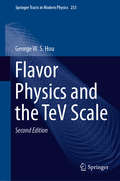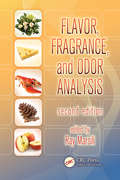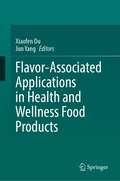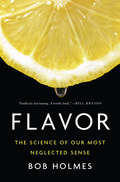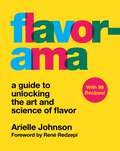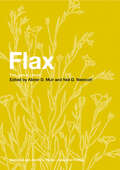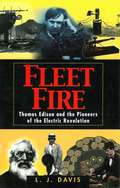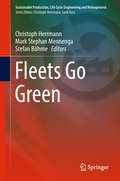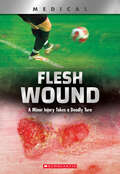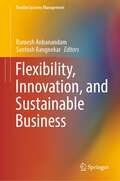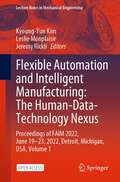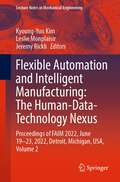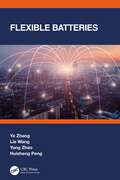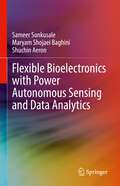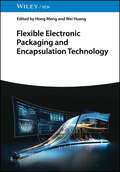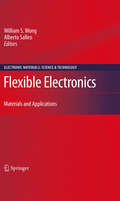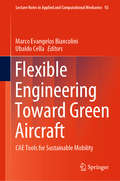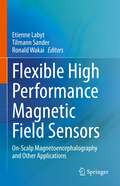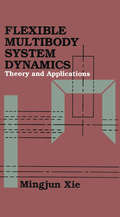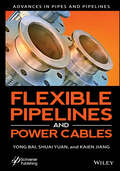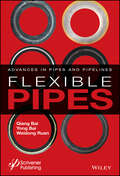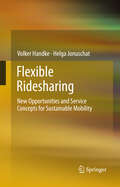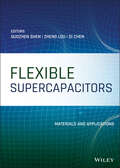- Table View
- List View
Flavor Physics and the TeV Scale (Springer Tracts in Modern Physics #233)
by George W. HouThe second edition of this monograph discusses the usefulness of heavy flavor as a probe of TeV-scale physics, exploring a number of recently-uncovered “flavor anomalies” that are suggestive of possible TeV-scale phenomena.The large human endeavor at the Large Hadron Collider has not turned up any New Physics, except the last particle of the Standard Model, the Higgs boson. Revised and updated throughout, this book puts the first results from the LHC into perspective and provides an outlook for a new era of flavor physics. The author readdresses many questions raised in the first edition and poses new ones. As before, the experimental perspective is taken, with a focus on processes, rather than theories or models, as a basis for exploration, and two-thirds of the book is concerned with b -^ s or bs sb transitions. In the face of the advent of Belle II and other flavor experiments, this book becomes a part of a dialogue between the energy/collider and intensity/flavor frontiers that will continue over the coming decade. Researchers with an interest in modern particle physics will find this book particularly valuable.
Flavor, Fragrance, and Odor Analysis
by Ray MarsiliThere are many advantages to stir bar sorptive extraction (SBSE) for isolating and concentrating flavor-active chemicals from foods, including its simplicity and wide application appeal. Written from a practical, problem-solving perspective, the second edition of Flavor, Fragrance, and Odor Analysis highlights this powerful technique and emphasizes
Flavor-Associated Applications in Health and Wellness Food Products
by Jun Yang Xiaofen DuHealth and wellness foods, snacks and beverages are of increasing importance to manufacturers as consumer interest in healthy lifestyles and the demand for healthier products and services continue to escalate. Transparency of the supply chain, traceability of the ingredients and processing methods and sustainability are the major concerns for modern consumers. Incorporating new ingredients with traditional products is an important strategy for the food industry to reformulate healthier and value-added foods, with the heart of health and wellness food products being flavoring ingredients, which deliver food and drink formats tasting just like the beloved original food products. To meet the growth of health and wellness food products in the market, new opportunities for flavor suppliers will include flavor raw materials and their applications in food products. Flavor-Associated Applications in Health and Wellness Food Products focuseson flavor and its application in health and wellness food products. The first section comprehensively covers the role of flavor in health and wellness products, while the second focuses on flavoring labels, ingredient suitability and safety with specific case studies. Further sections focus on sugar, fat, salt and alcohol reduction, flavor solutions for plant-based protein, flavor perception and direct health benefits. With no book on the current market focusing on health and wellness foods from a flavor perspective, this work is a valuable single source for product developers, manufacturers and researchers in need of a comprehensive summary of key recent developments regarding flavor-associated applications in health and wellness food products.
Flavor: The Science Of Our Most Neglected Sense
by Bob HolmesA journey into the surprising science behind our flavor senses. Can you describe how the flavor of halibut differs from that of red snapper? How the taste of a Fuji apple differs from a Spartan? For most of us, this is a difficult task: flavor remains a vague, undeveloped concept that we don’t know enough about to describe—or appreciate—fully. In this delightful and compelling exploration of our most neglected sense, veteran science reporter Bob Holmes shows us just how much we’re missing. Considering every angle of flavor from our neurobiology to the science and practice of modern food production, Holmes takes readers on a journey to uncover the broad range of factors that can affect our appreciation of a fine meal or an exceptional glass of wine. He peers over the shoulders of some of the most fascinating food professionals working today, from cutting-edge chefs to food engineers to mathematicians investigating the perfect combination of pizza toppings. He talks with flavor and olfactory scientists, who describe why two people can experience remarkably different sensations from the same morsel of food, and how something as seemingly unrelated as cultural heritage can actually impact our sense of smell. Along the way, even more surprising facts are revealed: that cake tastes sweetest on white plates; that wine experts’ eyes can fool their noses; and even that language can affect our sense of taste. Flavor expands our curiosity and understanding of one of our most intimate sensations, while ultimately revealing how we can all sharpen our senses and our enjoyment of the things we taste. Certain to fascinate everyone from gourmands and scientists to home cooks and their guests, Flavor will open your mind—and palette—to a vast, exciting sensory world.
Flavorama: A Guide to Unlocking the Art and Science of Flavor
by Arielle JohnsonAn irreverent, accessible, essential guide to the science of flavor and how to use it in your own kitchen, from the food scientist-confidante of some of the world’s best chefs, Arielle Johnson, with more than 75 recipes—plus a foreword by René Redzepi. “Arielle changed the way that I think about flavor, and in these pages, she will do the same for you” (René Redzepi, chef of Noma).Meet Arielle Johnson—she’s a flavor scientist (she loves flavor so much, she got a Ph.D. in the subject). She spends most of her time helping chefs better understand what’s going on beneath the hood of flavor and make delicious new foods. Now, with Flavorama, she shares this invaluable knowledge with home cooks everywhere. Mixing equal parts fun and braininess, Arielle dives into how chemistry, sensation, and craft unite to create flavor, distilling what flavor really is (molecules!) and how to get it to work for you (spotting patterns, breaking rules) in an easy-to-digest handbook.You don’t need a lab or a professional kitchen—or even a background in science—to get something out of the science of flavor. With Flavorama, you’ll be able to easily finesse flavor while cooking to give any dish a little oomph, easily swap out an ingredient for one you have on hand, use a recipe or technique to improvise something new, or boldly replicate a flavor. Out of basil for pesto? Pivot and use mint, shiso, or tarragon—all are members of the same “herbal-aromatic” flavor family—for a new-but-somehow-familiar herb sauce. Or add a drizzle of olive oil and a sprinkling of flaky salt to chocolate ice cream— a simple hack for deliciously complex flavor. Included are 99 recipes so you can hit the ground running with your new science-of-flavor knowledge: An Algorithm for a Minimalist but Excellent Dressing for LettuceUmami-Boosted Cacio e PepeChilled Soba Noodles with GrapefruitThe Meatiest Slow-Cooked MeatPanela-Coconut Iced CoffeePineapple Caramel SauceBurnt Scallion ButterUnder-appreciated–Spice Pumpkin PieCook with the creativity, confidence, and flexibility of a world-class chef and learn how to unlock the flavor potential of your ingredients, create your own dishes, make your own bitters, ferment your own miso, and much, much more. Charming illustrations and diagrams drawn by Arielle herself accompany this indispensable guidebook to flavor town.
Flax: The genus Linum
by Alister D. Muir Neil D. WestcottLinum usitatissimum is a widely distributed plant that has a long history of traditional use as both an industrial oil and fiber crop. It is known as linseed in the United Kingdom, or flax in North America. For the last 15 years, there has been a steadily growing interest in the medicinal and nutraceutical value of flax, including experimental evid
Fleas (Parasites)
by Buffy SilvermanAll about fleas! Learn what these yucky creatures are, how they work, and what and why they do what they do.
Fleet Fire: Thomas Edison and the Pioneers of the Electric Revolution
by L. J. DavisThe electric revolution, which eclipsed the Industrial Revolution by the end of the 19th century and continues to this day, changed our world forever. FLEET FIRE tells us how it all began. In an engaging and entertaining narrative, L. J. Davis fields a cast of both prominent and forgotten characters, from dedicated scientists and mischievous rogues to enlightened amateurs who lit the sparks of discovery. Franklin's kite, Davenport's electromagnet, Morse's telegraph, Cyrus Field's transatlantic cable, and Edison's phonograph are but a few of the achievements Davis discusses. Explaining the science in lucid prose, FLEET FIRE conveys the arc of discovery during one of the most creative epochs in the history of mankind.
Fleets Go Green (Sustainable Production, Life Cycle Engineering and Management)
by Christoph Herrmann Mark Stephan Mennenga Stefan BöhmeThe book presents the results of the research project Fleets Go Green from different engineering disciplines. It includes comprehensive empirical data as well as different methods and tools for evaluating and integrating electric vehicles into corporate fleets. Finally, the authors give recommendations for fleet owners, vehicle manufacturers and political decision. The aim of the joint research project Fleets Go Green was the integrated analysis and evaluation of the environmental performance of electric and plug-in-hybrid vehicles in everyday usage on the example of fleet operations. The potential of electric vehicles for reducing the harmful environmental impacts of road transport in everyday conditions can only be analyzed and evaluated in field tests. If electric vehicles should realize their potential to reduce emissions and minimize the consumption of resources, an integrated life cycle assessment is required.
Flesh Wound: A Minor Injury Takes a Deadly Turn (XBooks: Medical)
by Shea PhillipsWill they solve this medical mystery in time?When Bo Salisbury hurts his ankle playing soccer, doctors think it's a bad bruise. Soon his leg gets worse, and he feels very sick.High-interest topics, real stories, engaging design, and astonishing photos are the building blocks of the XBooks, a new series of books designed to engage and motivate reluctant and enthusiastic readers alike. How can a bite from a pet prairie dog cause a life-threatening illness? Where does the guinea worm, a parasite that lives under human skin, come from? How can a virus that attacks the brain be related to birds dropping dead at the zoo? With topics based in science, these action-packed books will help students unlock the power and pleasure of reading... and always ask for more!
Flexibility in Adaptation Planning: When, Where and How to Include Flexibility for Increasing Urban Flood Resilience (IHE Delft PhD Thesis Series)
by Mohanasundar RadhakrishnanThe magnitude and urgency of the need to adapt to climate change is such that addressing it has been taken up by the United Nations as one of the sustainable development goals - Goal 13 (SDG13) in 2015. SDG13 emphasises the need to strengthen resilience and adaptive capacity to climate related hazards and natural disasters. Coping with urban floods is one of the major needs of climate adaptation, where integration of climate change responses into flood risk management policies, strategies and planning at international, national, regional and local levels is now the norm. However, much of this integration lacks effectiveness or real commitment from stakeholders involved in adaptation planning and implementation. Hence this research has focused on integrating flexibility based adaptation responses into an urban flood risk management context. The research has synthesised flexible adaptation practices from several disciplines including information technology, automobile and aerospace manufacturing. The outcomes of the research are brought together in a framework for structuring local adaptation responses and an adaptation planning process based on flexibility concepts. The outcomes provide a way to assist with the identification of the appropriate nature and type of flexibility required; where flexibility can best be incorporated; and when is the most appropriate time to implement the flexible adaptation responses in the context of urban flooding.
Flexibility, Innovation, and Sustainable Business (Flexible Systems Management)
by Ramesh Anbanandam Santosh RangnekarThis book contains practical experiences, knowledge, and insights in the evolution, formulation, and implementation of strategies and models for flexibility, innovation, and sustainable business. The book discussed the increasing significance of a flexible approach by businesses as much as possible in every area of their work—from employment policies to supply chain management (SCM). It further links this flexible approach to a sustainability strategy, which is necessary to be competitive today and in the future. This business approach is necessary to create long-term value by considering how a given organization operates in the ecological, social, and economic environment. This is linked to the next theme of the book—innovation—which is fundamental for a business to improve its processes, develop new and improved products and services for the market, increase its efficiency, and, most importantly, get better profitability. The book also delves into another buzz word in business—analytics. Companies have widely embraced the use of analytics to streamline operations and improve processes. The book explores all these critical emerging areas through the chapters in its five sections and is invaluable for management students and researchers, practicing business managers, consultants, professional institutions, and government and corporate organizations.
Flexible Automation and Intelligent Manufacturing: Proceedings of FAIM 2022, June 19–23, 2022, Detroit, Michigan, USA (Lecture Notes in Mechanical Engineering)
by Kyoung-Yun Kim Leslie Monplaisir Jeremy RickliThis is an open access book. It gathers the first volume of the proceedings of the 31st edition of the International Conference on Flexible Automation and Intelligent Manufacturing, FAIM 2022, held on June 19 – 23, 2022, in Detroit, Michigan, USA. Covering four thematic areas including Manufacturing Processes, Machine Tools, Manufacturing Systems, and Enabling Technologies, it reports on advanced manufacturing processes, and innovative materials for 3D printing, applications of machine learning, artificial intelligence and mixed reality in various production sectors, as well as important issues in human-robot collaboration, including methods for improving safety. Contributions also cover strategies to improve quality control, supply chain management and training in the manufacturing industry, and methods supporting circular supply chain and sustainable manufacturing. All in all, this book provides academicians, engineers and professionals with extensive information on both scientific and industrial advances in the converging fields of manufacturing, production, and automation.
Flexible Automation and Intelligent Manufacturing: Proceedings of FAIM 2022, June 19–23, 2022, Detroit, Michigan, USA, Volume 2 (Lecture Notes in Mechanical Engineering)
by Kyoung-Yun Kim Leslie Monplaisir Jeremy RickliThis book gathers the second volume of the proceedings of the 31st edition of the International Conference on Flexible Automation and Intelligent Manufacturing, FAIM 2022, held on June 19 – 23, 2022, in Detroit, Michigan, USA. Covering four thematic areas including Manufacturing Processes, Machine Tools, Manufacturing Systems, and Enabling Technologies, it highlights advances in micro- and nanoscales processes, additive manufacturing, artificial intelligence and robotic applications, human-robot collaboration, as well as quality control, supply chain, industrial monitoring and management strategies. It also discusses important issues related to sustainability, waste management and remanufacturing. All in all, this book provides academicians, engineers and professionals with extensive information on both scientific and industrial advances in the converging fields of manufacturing, production, and automation.
Flexible Batteries
by Yang Zhao Huisheng Peng Ye Zhang Lie WangFlexible Batteries highlights the key advances in flexible batteries, a booming new direction in the energy storage field. The authors first introduce lithium-ion batteries, which are currently the most widely used batteries. Flexible aqueous batteries such as aqueous lithium-ion, sodium-ion, and zinc-ion batteries are discussed subsequently due to the safety concerns in organic electrolytes. Since flexible metal-air batteries are recognized as primary choices for the next generation, the authors take lithium-air and aluminum-air batteries as examples to explore their applications in flexible battery construction. They further summarize flexible batteries under the most challenging working conditions such as stretching and integrating flexible batteries with flexible energy harvesting devices, sensors, and supercapacitors. Covering both fundamental and application development, this book may effectively bridge academics and industry. It will be helpful not only to scholars and students studying materials science and engineering, chemical engineering, physics, energy science, and biomedical science but also to scientists and engineers in the industry.
Flexible Bioelectronics with Power Autonomous Sensing and Data Analytics
by Sameer Sonkusale Maryam Shojaei Baghini Shuchin AeronThis book provides readers with an introduction to the materials and devices necessary for flexible sensors and electronics, followed by common techniques for fabrication of such devices and system-level integration. Key insights into fabrication and processing will guide readers through the tradeoff choices in designing such platforms. A comprehensive review of two specific, flexible bioelectronic platforms, related to smart bandages for wound monitoring and thread-based diagnostics for wearable health, will demonstrate practical application at the system level. The book also provides a unique electrical engineering perspective by reviewing circuit architectures for low noise signal conditioning of weak signals from sensors,, and for low power analog to digital converters for signal acquisition. To achieve energy autonomy, authors provide several example of CMOS energy harvesting front end circuits and voltage boosters. Beyond circuit architectures, the book also provides a review of the modern theory of sampling and recovery of sparse signals, also known as compressed sensing. They then highlight how these principles can be leveraged for design and implementation of efficient signal acquisition hardware and reliable processing of acquired data for flexible electronic platforms.
Flexible Electronic Packaging and Encapsulation Technology
by Hong MengFlexible Electronic Packaging and Encapsulation Technology A systematic introduction to the future of electronic packaging Electronic packaging materials are among the most important components of the broader electronics industry, capable of facilitating heat dissipation, redistributing stress on electronic components, and providing environmental protections for electronic systems. Recent advances in integrated circuits, especially the development of flexible electronic technology, have placed increasingly stringent demands on the capabilities of electronic packaging. These technologies have the potential to reshape our world, and they demand a generation of engineers capable of harnessing that potential. Flexible Electronic Packaging and Encapsulation Technology meets this demand with an introduction to the cutting-edge technologies available to package electronic components, as well as the testing methods and applications that bring these technologies to bear on the industry. These packaging technologies promise to bring lightness, flexibility, and environmental friendliness to the next generation of electronic systems. Flexible Electronic Packaging and Encapsulation Technology readers will also find: Survey of commercial electronic packaging materials and patents for reference purposesGuidelines for designing high-performance packaging materials with novel structuresAn authorial team of leading researchers in the field Flexible Electronic Packaging and Encapsulation Technology is ideal for materials scientists, electronics engineers, solid state physicists, professionals in the semiconductor industry, and any other researchers or professionals working with electronic systems.
Flexible Electronics
by Alberto Salleo William S. WongThis excellent volume covers a range of materials used for flexible electronics, including semiconductors, dielectrics, and metals. The functional integration of these different materials is treated as well. Fundamental issues for both organic and inorganic materials systems are included. A corresponding overview of technological applications, based on each materials system, is presented to give both the non-specialist and the researcher in the field relevant information on the status of the flexible electronics area.
Flexible Engineering Toward Green Aircraft: CAE Tools for Sustainable Mobility (Lecture Notes in Applied and Computational Mechanics #92)
by Marco Evangelos Biancolini Ubaldo CellaThis book discusses the recent advances in aircraft design methodologies. It provides an overview of topics such as shape optimization, robust design and aeroelasticity, focusing on fluid-structure numerical methodologies to address static and dynamic aeroelastic problems. It demonstrates that the capability to evaluate the interaction between aerodynamics, inertia and elastic forces is important to avoid drag penalties, control system efficiency loss and generation of potentially dangerous phenomena, such as divergence, control reversal and flutter. The book particularly highlights the advances in “high fidelity” CFD-CSM coupling, describing the latest experimental research to validate the numerical fluid-structure interaction analysis methodologies resulting from the EU-funded RBF4AERO and RIBES projects.
Flexible High Performance Magnetic Field Sensors: On-Scalp Magnetoencephalography and Other Applications
by Etienne Labyt Tilmann Sander Ronald WakaiThis contributed volume reviews the latest advances in all the new technologies currently developed for MagnetoEncephaloGraphy (MEG) recordings, as well as sensor technologies and integrated sensor arrays for on-scalp MEG. The book gives an account of the first MEG imaging studies and explores the new field of feasible, experimental paradigms of on-scalp MEG. This is an ideal book for engineers, researchers, and students in the neurosciences interested in MEG imaging.
Flexible Multibody System Dynamics: Theory And Applications
by Mingjun XieThis volume examines the theoretical and practical needs on the subject of multibody system dynamics with emphasis on flexible systems and engineering applications. lt focuses on developing an all purpose algorithm for the dynamic simulation of flexible tree-like systems making use of matrix representation at all levels. The book covers new theories with engineering applications involved in broad fields which include; civil engineering, aerospace and robotics, as well as general and mechanical engineering. The applications include high temperature conditions, time variant contact conditions, biosystem analysis, vibration minimization and control.
Flexible Pipelines and Power Cables (Advances in Pipes and Pipelines)
by Yong Bai Shuai Yuan Kaien JiangThe technology, processes, materials, and theories surrounding pipeline construction, application, and troubleshooting are constantly changing, and this groundbreaking series, "Advances in Pipes and Pipelines," has been created to meet the needs of engineers and scientists to keep them up to date and informed of all of these advances. This latest volume in the series focuses on flexible pipelines and power cables, offering the engineer the most thorough coverage of the state of the art available. The authors of this work have written numerous books and papers on these subjects and are some of the most influential authors on flexible pipes in the world, contributing much of the literature on this subject to the industry. This new volume is a presentation of some of the most cutting-edge technological advances in technical publishing. This is the most comprehensive and in-depth series on pipelines, covering not just the various materials and their aspects that make them different, but every process that goes into their installation, operation, and design. This is the future of pipelines, and it is an important breakthrough. A must-have for the veteran engineer and student alike, this volume is an important new advancement in the energy industry, a strong link in the chain of the world's energy production.
Flexible Pipes: Advances in Pipes and Pipelines
by Qiang Bai Weidong Ruan Yong BaiRecent changes in the codes for building pipelines has led to a boom in the production of new materials that can be used in flexible pipes. With the use of polymers, steel, and other new materials and variations on existing materials, the construction and, therefore, the installation and operation of flexible pipes is changing and being improved upon all over the world. The authors of this work have written numerous books and papers on these subjects and are some of the most influential authors on flexible pipes in the world, contributing much of the literature on this subject to the industry. This new volume is a presentation of some of the most cutting-edge technological advances in technical publishing. This is the most comprehensive and in-depth book on this subject, covering not just the various materials and their aspects that make them different, but every process that goes into their installation, operation, and design. The thirty-six chapters, divided up into four different parts, have had not just the authors of this text but literally dozens of other engineers who are some of the world’s leading scientists in this area contribute to the work. This is the future of pipelines, and it is an important breakthrough. A must-have for the veteran engineer and student alike, this volume is an important new advancement in the energy industry, a strong link in the chain of the world’s energy production.
Flexible Ridesharing
by Volker Handke Helga JonuschatIndividual mobility is one of the most important needs of modern society and an important link between private, public and economic life. In contrast, transport also entails severe environmental and social burdens, foiling current efforts for sustainable development. As the main source of CO2 emissions, transport is a prominent driver for climate change, and individual car traffic is responsible for nearly a third of the total energy consumption. However, we have to consider that many commuters feel indeed very dependent on their car. Here, ridesharing promises to contribute to environmental protection, while still offering individual mobility. Although ridesharing options have been discussed since many years, internet and smartphones provide completeley new opportunities to find ridesharing partners today. Thus, this book deals with current efforts on implementing flexible internet- and phone-based ridesharing services. With a main focus on the users' perspective, their demands and acceptance limits, we aim to explore success factors for non-profit, but also commercial ridesharing concepts.
Flexible Supercapacitors: Materials and Applications
by Guozhen Shen Zheng Lou Di ChenFLEXIBLE SUPERCAPACITORS Comprehensive coverage of the latest advancements in flexible supercapacitors In Flexible Supercapacitors: Materials and Applications, a team of distinguished researchers deliver a comprehensive and insightful exploration of the foundational principles and real-world applications of flexible supercapacitors. This edited volume includes contributions from leading scientists working in the field of flexible supercapacitors. The book systematically summarizes the most recent research in the area, and covers fundamental concepts of electrode materials and devices, including on-chip microsupercapacitors and fiber supercapacitors. The latest progress and advancements in stretchable supercapacitors and healable supercapacitors are also discussed, as are problems and challenges commonly encountered in the development of flexible supercapacitors. The book concludes with suggestions and fresh perspectives on future research in this rapidly developing field. Flexible Supercapacitors: Materials and Applications also offers: A thorough introduction to the fundamentals of supercapacitors, including their materials and devices Comprehensive explorations of flexible fiber supercapacitors and two-dimensional materials for flexible supercapacitors In-depth examinations of flexible supercapacitors with metal oxides-based electrodes and flexible on-chip microsupercapacitors Practical discussions of stretchable and healable supercapacitors, as well as patterned nanostructured electrodes Perfect for researchers in the fields of materials science, physics, and electrical engineering, Flexible Supercapacitors: Materials and Applications is also an ideal reference for developers interested in supercapacitor design, materials, and devices.
